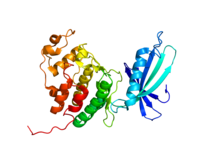
Photo from wikipedia
Background Although physiologic transition from rhythmic contractions to uterine retraction postpartum remains a poorly understood process, it has been shown that the latter is essential in the prevention of hemorrhage… Click to show full abstract
Background Although physiologic transition from rhythmic contractions to uterine retraction postpartum remains a poorly understood process, it has been shown that the latter is essential in the prevention of hemorrhage and its negative consequences. Objective To investigate the transition from oscillatory contractions to tonic contracture in human myometrium after delivery, a mechanism purported to facilitate postpartum hemostasis. Protein kinase C (PKC) plays a key regulatory role in human uterine contractions because it can prevent dephosphorylation of regulatory proteins and sensitize the contractile machinery to low Ca2+. Thus, activation of PKC by phorbol 12,13‐dibutyrate (PDBu) may act as a strong uterotonic agent. Study Design Uterine biopsies were obtained from consenting women undergoing elective caesarian delivery at term without labor (N = 19). Isometric tension measurements were performed on uterine strips (n = 114). The amplitudes and area under the curve of phasic contractions and tonic responses were measured and compared. A total of 1 &mgr;M PDBu was added to the isolated organ baths, and maximal tension of the uterine contracture was determined in the absence and presence of either 1 &mgr;M of staurosporine, 100 nM nifedipine, or 10 &mgr;M cyclopiazonic acid to assess the role of PKC and calcium sensitivity on uterine contractility. Results On the addition of PDBu on either basal or oxytocin‐induced activity, consistent contractures were obtained concomitant with complete inhibition of phasic contractions. After a 30‐minute incubation period, the mean amplitude of the PDBu‐induced tone represented 65.3% of the amplitude of spontaneous contraction. Staurosporine, a protein kinase inhibitor, induced a 91.9% inhibition of PDBu contractures, a process not affected by nifedipine or cyclopiazonic acid, thus indicating that this mechanism is largely Ca2+ independent. Conclusion Pharmacologic activation of PKC leads to a significant contracture of the myometrium. Together, these data suggest that the up‐regulation of PKC plays a physiologic role in the modulation of uterine contracture after delivery. A switch from phasic to strong tonic contractions potentially may facilitate postpartum hemostasis.
Journal Title: American Journal of Obstetrics and Gynecology
Year Published: 2017
Link to full text (if available)
Share on Social Media: Sign Up to like & get
recommendations!